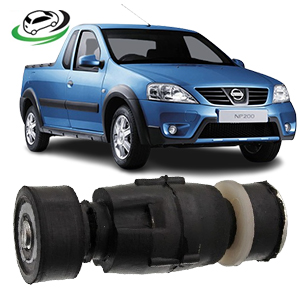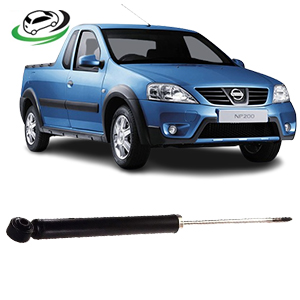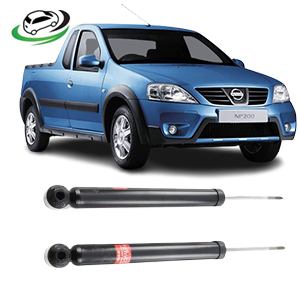-7%
Get Nissan Pick Up NP200 Shock Absorber-Rear Suspension RH/LH 343482
The Shock Absorber in the Rear Suspension is one of the most critical components in a vehicle’s suspension system, designed to provide a smooth ride by absorbing and dampening the impact of road irregularities. Shock absorbers work in tandem with springs and other suspension elements to ensure that the vehicle maintains stability, handling, and comfort by controlling the movement of the wheels relative to the chassis. Without shock absorbers, a vehicle would bounce uncontrollably, making it difficult to drive safely and comfortably.
In this detailed 1000-word explanation, we will cover the structure, function, types, benefits, maintenance, and symptoms of failure for the rear shock absorber in a vehicle’s suspension system.
Structure of the Rear Shock Absorber
The basic structure of a shock absorber consists of several key components:
- Cylinder (Body): The main body or cylinder houses the internal components of the shock absorber. It contains oil or gas, which is used to control the movement of the suspension. Most shock absorbers are made from steel or aluminum, providing durability and resistance to the harsh conditions of the road.
- Piston: Inside the cylinder, the piston is the key component that moves up and down within the body of the shock absorber. As the vehicle hits bumps or dips in the road, the piston moves, displacing oil or gas and creating resistance that dampens the motion of the suspension.
- Piston Rod: The piston is attached to a piston rod, which extends out of the top of the cylinder. The piston rod connects the shock absorber to the vehicle’s chassis and moves with the suspension as the vehicle drives over uneven surfaces.
- Hydraulic Fluid (Oil): In most traditional shock absorbers, hydraulic fluid is used to create resistance as the piston moves within the cylinder. As the piston moves, it forces the oil through small holes or valves, creating damping resistance that slows the movement of the suspension.
- Valves: Valves are located inside the cylinder, controlling the flow of hydraulic fluid as the piston moves. The size and design of these valves determine the amount of resistance generated, affecting the stiffness or softness of the ride.
- Gas Chamber (in Gas-Charged Shocks): Some modern shock absorbers use gas, such as nitrogen, in addition to hydraulic fluid to provide more consistent performance, especially in extreme conditions. Gas-charged shock absorbers have a gas chamber that prevents the oil from foaming, maintaining better performance during rapid suspension movements.
- Mounting Points: The shock absorber is connected to the vehicle’s frame and suspension system at the top and bottom via mounting points or brackets. These mounting points may include rubber bushings to help reduce noise and vibrations.
Function of the Rear Shock Absorber
The primary function of the rear shock absorber is to control the movement of the vehicle’s suspension, keeping the tires in contact with the road surface. This ensures stability, control, and comfort for both the driver and passengers. Specifically, shock absorbers serve the following functions:
- Damping Suspension Movement: Shock absorbers prevent the suspension from oscillating after hitting a bump or dip. Without them, the vehicle would bounce excessively, making it difficult to maintain control. The shock absorber converts the kinetic energy from the suspension movement into heat, dissipating it in the hydraulic fluid and stabilizing the vehicle.
- Maintaining Tire Contact with the Road: Shock absorbers ensure that the tires maintain consistent contact with the road surface, which is critical for braking, accelerating, and cornering. When the suspension moves too freely, the tires can lose contact with the road, leading to poor handling and a loss of control.
- Reducing Body Roll: Shock absorbers play a role in reducing body roll, particularly during cornering. Body roll occurs when the vehicle leans to one side during a turn, and shock absorbers help to dampen this effect by controlling the lateral movement of the suspension.
- Improving Ride Comfort: By absorbing the impact of road irregularities like potholes, speed bumps, and rough terrain, shock absorbers help provide a smoother and more comfortable ride. They prevent the chassis from feeling the full impact of these bumps, improving comfort for the passengers.
- Enhancing Vehicle Stability: Shock absorbers contribute to the overall stability of the vehicle, especially at high speeds or when driving on rough terrain. They ensure that the vehicle doesn’t sway excessively, improving driver control and reducing the risk of accidents.
Types of Rear Shock Absorbers
Shock absorbers come in various types, each designed for different vehicle applications and driving conditions. The main types of rear shock absorbers are:
- Hydraulic (Oil-Filled) Shock Absorbers: These are the most common type of shock absorbers and rely on hydraulic fluid to dampen suspension movement. When the piston moves inside the cylinder, it pushes oil through small valves, creating resistance that slows the movement of the suspension.
- Gas-Charged Shock Absorbers: These shock absorbers add pressurized nitrogen gas to the hydraulic fluid. The gas reduces the chances of the hydraulic fluid foaming, which can happen when the suspension moves quickly. Gas-charged shocks provide more consistent damping and are especially useful for high-performance or off-road vehicles.
- Twin-Tube Shock Absorbers: Twin-tube shocks have two cylinders—one inner cylinder for the piston and hydraulic fluid, and an outer cylinder that acts as a reservoir for excess fluid. This design allows for a more compact shock absorber and is commonly used in passenger vehicles.
- Mono-Tube Shock Absorbers: Mono-tube shocks have a single cylinder that contains both the hydraulic fluid and gas. This design allows for better heat dissipation and is commonly used in performance vehicles or off-road applications. Mono-tube shocks provide more responsive damping compared to twin-tube shocks.
- Adjustable Shock Absorbers: Some shock absorbers are adjustable, allowing the driver or technician to modify the damping characteristics based on driving conditions. These are often found in high-performance or custom vehicles where precise suspension tuning is desired.
- Air Shock Absorbers: Air shocks use air chambers in place of hydraulic fluid or gas. The air pressure can be adjusted to raise or lower the vehicle’s ride height, making them ideal for vehicles that tow heavy loads or require variable ride heights.
Importance of Rear Shock Absorbers
Rear shock absorbers are vital for several aspects of vehicle performance, including:
- Ride Comfort: Rear shock absorbers help smooth out the ride by absorbing bumps and vibrations from the road. Without them, passengers would experience a rough and uncomfortable ride, particularly on uneven terrain.
- Handling and Control: Properly functioning rear shock absorbers ensure that the vehicle handles predictably, especially during cornering and sudden maneuvers. They minimize body roll and keep the vehicle stable, improving safety and control.
- Tire Wear: Rear shock absorbers play a significant role in prolonging the life of the tires. When shocks are worn or damaged, the tires can bounce excessively, leading to uneven wear patterns and premature tire failure.
- Brake Performance: Shock absorbers also affect braking performance. If the shocks are worn, the vehicle’s weight may shift excessively during braking, causing the rear end to lift and reducing braking efficiency.
- Safety: By maintaining vehicle stability, especially on rough roads or during sharp turns, rear shock absorbers enhance overall safety. Poorly functioning shocks can lead to loss of control, especially in adverse driving conditions.
Maintenance of Rear Shock Absorbers
Regular maintenance of rear shock absorbers is crucial for ensuring their longevity and optimal performance. Here are some key maintenance tips:
- Regular Inspection: Inspect the rear shock absorbers during routine vehicle maintenance or if you notice any signs of suspension issues. Check for oil leaks, damaged mounting points, or worn-out rubber boots.
- Replace Worn Shock Absorbers: Shock absorbers should be replaced every 50,000 to 100,000 miles, depending on driving conditions and vehicle usage. Worn shocks lose their ability to control suspension movement, compromising handling and comfort.
- Check for Noise: If you hear clunking or rattling noises from the rear suspension, it could indicate worn or damaged shock absorbers. These noises often occur when the internal components are damaged, allowing the piston to move freely without damping the suspension.
- Test for Bounce: A simple way to test the shock absorbers is by pushing down on the rear of the vehicle. If the vehicle bounces more than once before stabilizing, the shocks are likely worn and need to be replaced.
- Inspect Suspension Components: Along with the shocks, inspect other suspension components, such as springs, control arms, and bushings. A worn shock can lead to increased wear on these components, so it’s important to address any issues early.
Symptoms of Failing Rear Shock Absorbers
Several symptoms can indicate that your rear shock absorbers are failing, including:
- Excessive Bouncing: If your vehicle bounces excessively after hitting a bump, it’s a clear sign that the rear shocks are worn out and no longer providing adequate damping.
- Rough Ride: A noticeable decline in ride comfort, especially on rough or uneven roads, can indicate worn rear shocks.
- Uneven Tire Wear: Failing shock absorbers can cause the tires to wear unevenly, as the suspension is unable to keep the tires in constant contact with the road.
- Nose Diving: During hard braking, the rear of the vehicle may lift and the front may dive down, indicating that the rear shock absorbers are not properly controlling the vehicle’s weight distribution.
- Leaking Fluid: If you notice hydraulic fluid leaking from the rear shock absorbers, it’s a clear sign that they are damaged and need to be replaced.
- Poor Handling: If the vehicle feels unstable or sways excessively during turns, it could indicate that the rear shock absorbers are no longer functioning correctly.
Conclusion
The Rear Shock Absorber is a vital part of the vehicle’s suspension system, ensuring that the car remains stable, comfortable, and safe to drive. By damping the movement of the suspension and maintaining tire contact with the road, shock absorbers play a key role in handling, braking, and ride quality. Regular maintenance, timely replacement, and recognizing the symptoms of a failing shock absorber can significantly improve the safety and performance of your vehicle. Properly functioning rear shock absorbers ensure that your vehicle can handle the challenges of the road while providing a smooth and comfortable ride for all passengers.
Follow us on Facebook for more parts.





